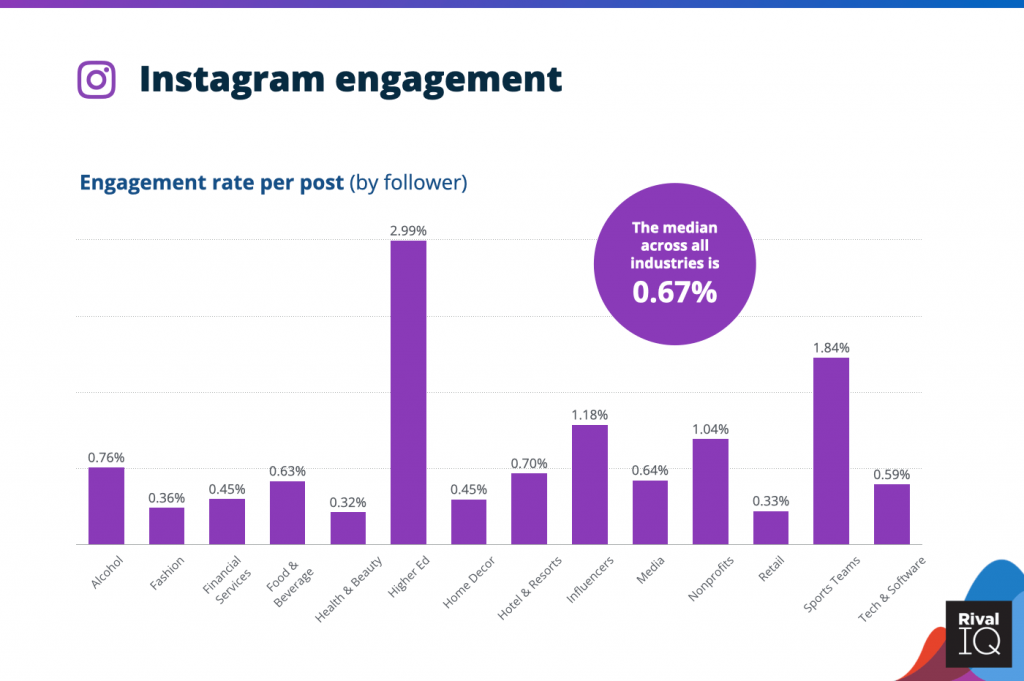There’s bad news for all those Instagram aficionados out there – engagement is down by 30%.
A report by Rival IQ has illustrated how the engagement rate per post dropped from 0.98% in 2021 to 0.67% in 2022. However, the drop is not necessarily unique to Insta, with Twitter and Facebook also witnessing declining engagement for businesses through the same window.
Rival IQ took measurements from 150 companies at random from 14 industries based on a database of over 200,000 brands. The industries looked at were: Alcohol, Fashion, Financial Services, Food & Beverage, Health & Beauty, Higher Education, Home Decor, Hotels & Resorts, Influencers, Media, Non-profits, Retail, Sports Teams, and Tech & Software.
The report’s engagement measures are based on total interactions across organic and boosted social media posts, including shares, ration, retweets, comments, and reactions. Rival IQ then takes the total number of interactions and divides it by an account’s following. For example, if your post had three interactions, you’d get your engagement figure by dividing three by your follower account.
Key study takeaways
The report also discovered a few tips and tricks that marketers can use to fight against the dying of the light:
- Use more giveaways and hashtag holidays in your content mix.
- Post carousels on Instagram as these are ultra-engaging.
- Use video – in this new age of social media; video cannot be ignored.
- Post more to help improve those engagement figures.
If you thought Instagram’s numbers were rough, wait until you see what’s happening on Facebook.
Rival IQ found that the average post gets less than 1% engagement (0.064%) from a median of 5.87 posts per week. Engagement is higher for influencers (0.23%) and sports teams (0.27), which isn’t surprising, given they tend to have a highly engaged audience. Tech & software did the worst (0.02%), followed by health & beauty (0.02%) and fashion (0.03%).
Instagram
As mentioned earlier, Instagram has seen a drop in numbers. Two years ago, its engagement was nearly double (1.22%). It now sits at 0.67%.
Interestingly, higher education gets great engagement numbers (2.99%), followed by sports teams (1.84%) and influencers (1.18%).
Health & beauty (0.32%) and retail (0.33%) do the worst. Regular posting is around 4.55 posts a week.
Accounts that post video content like Reels do better – so don’t sweat on that video strategy you’ve been working on.
Engagement has also gone down at Twitter, sitting at 0.037% from an average of 5.04 tweets per week. Twitter engagement has never been the highest, but the drop does suggest that audiences aren’t going wild for new products such as Topics and Spaces. Although, it’s never a bad idea to play around with the new toys that come into the social space.
Again sports teams do best (0.084%), followed by higher education (0.071%) and alcohol (0.055%). Media (0.011%) and retail (0.018%) do worst.
The perfect competition
The report highlighted that running competitions remains an effective way of boosting engagement. There are various ingredients to running a good social media competition; however, be mindful that regulations vary between platforms and are subject to change.
Competitions are a great way to grow an audience and bring new people face-to-face with your brand. It can also help you collect killer user-generated content.
Video across industries
Video is the future, but it isn’t the best strategy for every brand, according to the report.
Carousels outperformed video for alcohol, food & beverage, non-profit, fashion brands
However, health & beauty pages can boost engagement by investing in more video content, especially on Facebook. Higher education, tech & software, home decor, media accounts should focus on videos to boost engagement.
For example, videos and photos were top of the chart for engagement for media brands on Facebook, even though link posts were 15x more prominent. In general, video content on Twitter does well in terms of engagement and some thought should be put into investing across that.
The rise of Reels on Insta and the introduction of more short-form video on Facebook means that brands and marketers of every ilk should consider video as part of their social media mix.
Looking good!
Across the board, influencers did well. Influencers earned 3.5x the average engagement on Facebook and crushed it on Instagram (2x the median engagement). But there is room for improvement, as the report suggests posting more photos on Facebook and utilising the top-performing #tbt by going nostalgic on your audience.
…for everyone?
Global uncertainty tends to push up time spent and usage, as we’ve seen in recent weeks. Engagement rates on Facebook and Twitter held steady as people looked for news updates, but don’t be shy with those visual posts! Video and photos earned top engagement rates on Facebook and Twitter, while carousels did better at Instagram.




RECOMMENDED FOR YOU
X (Twitter) To Sell Dormant Brand Handles
X, formerly Twitter, is launching a new Handles Marketplace…
X, formerly Twitter, is launching a new Handles Marketplace…
[STUDY] ChatGPT Powers Work And Life
OpenAI, in collaboration with Harvard economist David Deming, has…
OpenAI, in collaboration with Harvard economist David Deming, has…
LinkedIn Tests New Premium Tools for SMBs
LinkedIn is quietly piloting a new Premium offering designed…
LinkedIn is quietly piloting a new Premium offering designed…